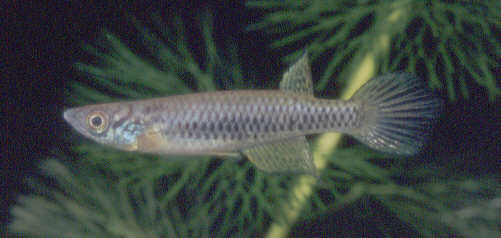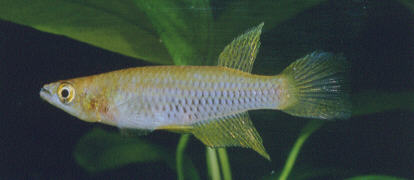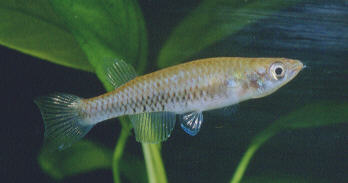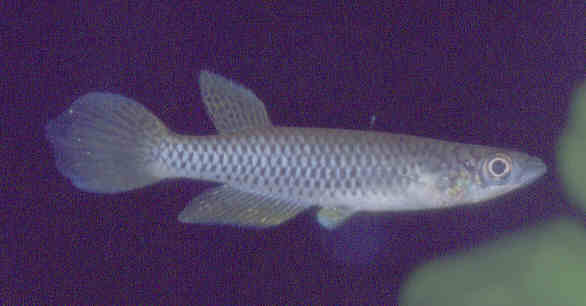Epiplatys sangmelinensis (Ahl 1928)

E.sangmelinensis
Sangmelina. Wild male.
Photo courtesy of Ed Pürzl.
| Meaning of Name |
After Sangmelima. |
|||
| First Description |
Ahl E. 1928. Beiträge zur Systematik der afrikanische Zahnkarpfen. Zoologischer Anzeiger 79 (3-4): p 118, figure 4. |
|||
| Size |
7 cm |
|||
| Meristics |
|
|||
| Karyotype |
n = 24 (Scheel 1968) |
|||
| Sub-Genus |
Epiplatys |
|||
| Group |
sangmelinensis |
|||
| Synonyms |
|
|||
Populations
|
|
|||
| Type Locality |
Sangmelima, situated on the upper Lobo River, southern Cameroon. |
|||
| Distribution |
The inland plateau of southern Cameroon where they inhabit the upper Dja (Zaire), upper Nyong, Ntem & upper Sanaga River drainage systems. The range northerly extends to Yaunde, southerly it reaches close to the Gabon border. Easterly the extends to Doumé, an area between Abong Mbang & Bertoua. Scheel in ROTOW 1 page 371 also reported collecting a male in the Mambaka River which is an affluent of the Mbéré. This flows into the Logone River in the Chad drainage. It was a surprising find as this locality is some 300 km north-northeast of the forest area they are known to inhabit & in true savannah. http://homepage.uibk.ac.at/homepage/c102/c102mr/epiplaty/sangmeli.htm |
|||
| Habitat |
Covered by forest. Found in small streams, brooks
& swamps. |
|||
| Distinguishing Characteristics | Before
E.neumanni was described the new fish
were sometimes referred to as E.sangmelinensis
or E.aff.sangmelinenis.
E.neumanni is a stockier, shorter
species. E.neumanni has more pronounced
vertical bands on the body. Berkenkamp in the description of E.neumanni
stated that the two species could be seperated by the pattern of frontal
neuromasts & the colour pattern of the throat. A fairly colourless species. |
|||
| Colour/Pattern Variability | Low | |||
| History |
There are a few loose ends with this sp. in that 2 males caught by Higgins in 1872 may correspond to E.sangmelinensis. These are deposited in the British Museum of Natural History. See ROTOW 1 pp 287 & 374. Also Bates collected specimens in 1903 which may belong to this sp. Again, they are deposited in the British Museum of Natural History. Ahl described Panchax sangmelinensis in 1928 from a single specimen collected at the upper reaches of the Lobo River near Sangmelima by Schreiner. Holly in 1930 examined this specimen & changed some of the meristic data. Scheel collected this species from various localities around Sangmelima in 1966. He collected E.sangmelinensis in wooded areas of the inland plateau but it was less common than A.exiguum & A.obscurum? he also collected. Live fish were collected 30 km north of Sangmelima & taken back to Copenhagen (probably by Scheel from the 1966 collection, although it does not state that in ROTOW 1 p372.). Scheel stated that these fish were 'shy & difficult to keep alive'. Nine fry hatched from breeding attempts but all died one by one. They were collected by Mr.J.P.Vlamink & brought into Holland in November 1971 where they were received by Mr.B.J.Schrieken of Den Helder. Collected by Radda in 1971 8km east of Sangmélima. Heinemann, Lenz et al collected in late 1978/early 1979 at Etondo, 34kms east of Ebolowa towoards Sangmélima. No other Kiliies collected. Roland Numerich in February 1987 collected them between Belinga & Mayebut on the Ivindo River. Amiet collected in 1987 at Avonbengon between Mintom & Djoum. Grell & Eberl collected 8th August 1991 in the Otongbibé stream near Avonbengon. History of the synonym Panchax nyongensis Ahl 1928 Ahl described this species from a single specimen collected by Rosenberg in the Nyong River drainage. Holly, in 1930, examined the holotype & changed some of Ahl's data.
|
|||
| Breeding Notes |
I only had this species once & found it difficult to breed, only laying a few eggs in mops. They hide a lot & a darkened tank suits them best. Reports suggest that the pairs will not harm eggs or fry in the breeding tank. Water incubation is 12-15 days. Fry will take newly hatched brine shrimp on hatching. Growing the fry is difficult (I didn't manage to raise any) with sexual maturity taking at least around 8 months. |
|||
| Diameter of Egg | 1·7 mm | |||
| Remarks |
A difficult fish to find in the hobby. Commercial shipments do very rarely contain one or two specimens which need special care to bring them into breeding condition. |


